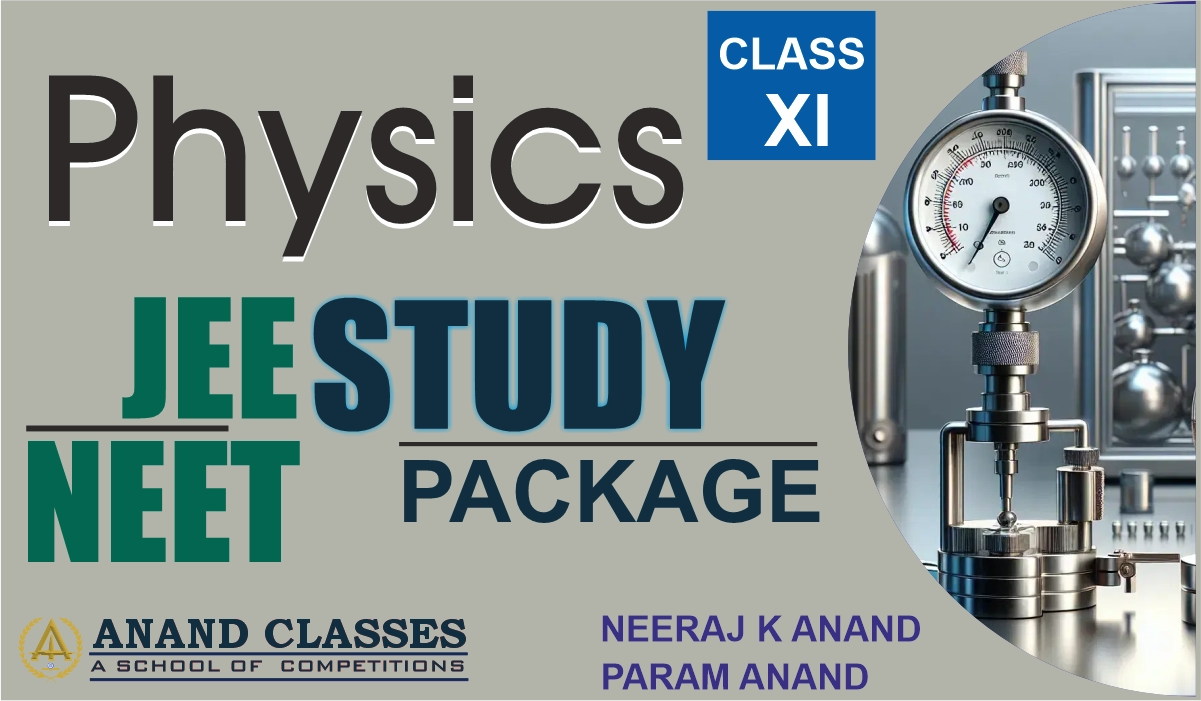📌 Related Posts:
Difference Between Gravitation & Gravity | JEE,NEET & Class 11 | MCQs & Questions and Answers
|
Vectors-JEE Advanced Previous Year Questions with Solutions
|
Gravitational Potential Energy-Derivations, Formulas, Examples | JEE NEET Notes
|
NEET MCQs-Horizontal Projectile Motion
|
Speed(Velocity)-Time Graphs Cases, Area Under Speed-Time Curve Gives Distance Travel
📋 Explore More:
-- Choose a post --
Motion in a Plane-Practice Questions with Answers & Explanations
Motion in a Plane-NCERT Exemplar Solution Class 11 Physics
Inclined Plane – Motion of Objects on an Incline, Solved Problems
Vectors – Types, Properties, Polygon, Parallelogram Law, Dot,Cross Product – IIT JEE Class 11 Physics Notes
Vector and Scalar-Definition, Vector Addition and Subtraction, Differences, Solved Problems
Types of Vectors-Physics Class 11 CBSE Notes
Vectors-Questions with Solutions Class 11 Physics Notes
Vector Properties|Equality of Vectors|Unit Vector
Position Vector | Displacement Vectors | Examples | Class 11 Physics
Vector Laws Formulas and Equations with Solved Examples Class 11 Physics
Vectors Addition and Subtraction Laws-Solved Examples
Vector And Scalar Quantities – Definition and Examples
Vectors-JEE Advanced Previous Year Questions with Solutions
Components of a Vector And Unit Vectors-Class 11 Physics Notes
Triangle Law of Vector Addition-Formula And Derivation-Class 11 Physics Notes
Scalars and Vectors Questions with Answers Physics Class 11 Study Material
Scalar And Vector Products Notes-Class 11 Physics
Velocity Components of Vectors, Solved Examples-Class 11 Physics Notes
Concept of Vector Addition, Explanation and Important Questions
Dot Product Of Two Vectors | Definition, Properties, Formulas and Examples
NEET MCQs-Fundamentals of Vectors
NCERT Solutions-Motion In A Plane Class 11 Physics Notes
Projectile Motion – Definition, Formula, Examples, Concepts, FAQs
Projectile Motion-MCQs,Important Questions and Answers
Projectile Motion Properties-Class 11 Physics Study Material
Horizontal Projectile Motion-Class 11 Physics Notes
NEET MCQs-Horizontal Projectile Motion
What is Horizontal Range in Projectile Motion?
Newton’s Laws of Motion – Three Laws of Motion Explanation, Examples
Laws of Motion-CBSE Class 11 Physics Notes Study Material
What are the three Laws of Motion?-Class 11 Physics Notes
Newton’s Second Law Of Motion – Derivation, Applications, Solved Examples and FAQs
Newton’s Third Law of Motion – Explanation, Solved Examples and FAQs
Force and Motion: Formula, Unit, Relation, Law Of Motion.
Inertia – Definition, Laws of inertia, Types, Examples, FAQs
Laws of motion MCQs for NEET Physics Class 11
Law Of Conservation Of Linear Momentum – Principle, Formula & Examples
Conservation Of Momentum – Definition, Formula, Examples
Conservation Of Momentum – Derivation, Definition-Formula, Examples, Applications, FAQs
Conservation of Linear Momentum Formula and Examples-Class 11 Physics
IIT JEE Notes-Law of Conservation of Linear Momentum
State the law of conservation of momentum-Class 11 Physics Study material
Momentum And Its Conservation Formula-Solved Examples
Elastic and Inelastic Collision-Conservation of Momentum-Solved Examples
Derive Law Of Conservation Of Momentum-Class 11 Physics Notes
Mass,Inertia,Weight and Momentum-Class 11 Physics Study material
Law of Conservation of Linear Momentum Questions Answers and Explanations
CBSE Syllabus for Class 11 Physics with Marking Scheme PDF for Download
Newton’s Law of Gravitation, Gravitational Force|JEE,NEET & Class 11| MCQs & Questions and Answers
Gravitational Force Examples and Explanations | Class 11 Physics Notes, Important Questions & Answers
Vector Form of Newton’s Law of Gravitation | Gravitation Class 11 Physics Notes, Important Questions & Answers
Principle of Superposition of Gravitational Forces | Gravitation Class 11 Physics Notes, Important Questions & Answers
Derivation of Newton’s Law of Gravitation from Kepler’s Law | Class 11 Physics Notes, Important Questions & Answers
Force of Gravitation Formula Numericals, Solved Examples, Important Questions-Answers
Difference Between Gravitation & Gravity | JEE,NEET & Class 11 | MCQs & Questions and Answers
Acceleration Due to Gravity | Formula, Derivation, Important Questions & Answers, JEE, NEET & CBSE Class 11 Notes
Effects on Acceleration Due to Gravity (g) with Height (h) | Gravitation Class 11 Physics Notes, Important Questions & Answers, MCQS, Quiz
Effect on Acceleration Due to Gravity (g) at Depth d | Gravitation Class 11 Physics Notes, Important Questions & Answers, MCQS, Quiz
Variation of Acceleration Due to Gravity (g) due to Shape of Earth | Notes, Important Questions & Answers, MCQS, Quiz
Variation of Acceleration Due to Gravity (g) due to Rotation of Earth | Notes, Important Questions & Answers, MCQS, Quiz
Comparison Between Inertial & Gravitational Mass | Notes, Important Questions & Answers, MCQS, Quiz
Difference Between Mass & Weight | Gravitation Class 11 Physics Notes, Important Questions & Answers, MCQS, FAQs
Gravitational Field Intensity | JEE, NEET & CBSE Board Class 11 Exams Notes
Gravitational Field Intensity due to Ring | JEE, NEET & CBSE Board Class 11 Exams Notes
Gravitational Field due to Uniform Spherical Shell | JEE NEET & CBSE Board Class 11 Exams Notes
Gravitational Field Intensity due to Uniform Solid Sphere | JEE NEET & CBSE Board Class 11 Exams Notes
Gravitational Potential Energy-Derivations, Formulas, Examples | JEE NEET Notes
Gravitational Potential & Relation With Gravitational Potential Energy-Derivation, Formula, Examples | JEE NEET CBSE Class 11 Notes
Difference between Gravitational Potential and Gravitational Potential Energy | JEE NEET CBSE Class 11 Notes
Mass & Density of Earth | JEE, NEET & CBSE Class 11 Study Material, MCQS, Quiz, FAQS
Escape Velocity-Definition, Derivation, Solved Examples, MCQS, FAQs, Quiz | JEE, NEET & CBSE Class 11 Exams Study Material
Orbital Velocity of Satellite-Formula, Derivation, Solved Examples
Geostationary Satellite | JEE, NEET & CBSE Class 11 Exams Study Material
Difference between Escape and Orbital Velocity | JEE, NEET & CBSE Class 11 Study Material, MCQS, Quiz, FAQS
Height & Time Period of Geosynchronous Satellite | JEE NEET & CBSE Class 11 Study Material, MCQS, Quiz, FAQS
Total Energy (Kinetic & Potential Energy) of Satellite | JEE NEET & CBSE Class 11 Study Material, MCQS, Quiz, FAQS
Binding Energy & Angular Momentum of Satellite | JEE NEET & CBSE Class 11 Study Material, MCQS, Quiz, FAQS
Weightlessness-Zero Gravity | JEE NEET & CBSE Class 11 Study Material, MCQS, Quiz, FAQS
Kepler’s Laws-First, Second & Third Law of Planetary Motion
Universal Law of Gravitation-Complete Study Material for JEE, NEET & CBSE Class 11
Physical Quantities-Questions & Answers, MCQs, Worksheet, & Explanations | JEE NEET CBSE Class 11 Notes
Fundamental & Derived Quantities-Questions, Answers, MCQs, FAQs & Worksheet | JEE NEET CBSE Class 11 Notes
CGS, MKS, SI-System of Units | Questions, Answers, MCQs, FAQs & Worksheet | JEE, NEET, CBSE Board Class 11 Exams
SI (Metric) Prefixes Class 11 CBSE-Questions, Answers, MCQs, FAQs & Worksheet
Seven SI Base Units of Measurement-Explanations, MCQs, FAQs & worksheets, CBSE Class 11
Practical Units of Length, Mass, Time-JEE, NEET, Class 11 Physics | Explanations, FAQs, MCQs, Worksheets
Advantages of SI System of Units | Study Materials, worksheets, Practice Questions for JEE, NEET, CBSE Board Class 11 exams
SI Units & Their Conventions Class 11 Physics | Question-Answer, FAQS, Worksheet, MCQS, Test Paper
Supplementary Units (Radian & Steradian) Class 11 Physics | Question-Answer, FAQS, Worksheet, MCQS, Test Paper
Light Year, Astronomical Unit, Parsec Units-Class 11 Physics | Question-Answer, FAQS, Worksheet, MCQS, Test Paper
Dimensions of Fundamental Physical Quantities-Class 11 Physics | Question-Answer, FAQS, Worksheet, MCQS, Test Paper
Dimensional Formulas of Physical Quantities Used in Mechanics | Class 11 Physics | Question-Answer, FAQS, Worksheet, MCQS, Test Paper
Dimensional Formulas of Physical Quantities Used in Heat | Class 11 Physics | Question-Answer, FAQS, Worksheet, MCQS, Test Paper
Dimensional Formulas of Physical Quantities Used in Electricity | Class 11 Physics | Question-Answer, FAQS, Worksheet, MCQS, Test Paper
Quantities Have Same Dimensions Class 11 Physics | Question-Answer, FAQS, Worksheet, MCQS, Test Paper
Important Unit Conversions in Physics | Question-Answer, FAQS, Worksheet, MCQS, Test Paper
Physical Quantity Constants for Physics | Question-Answer, FAQS, Worksheet, MCQS, Test Paper
Dimensional Formulas for Physical Quantities | Derived SI units with Special Names | Quantities Have Same Dimensional Formula
Applications (Uses) of Dimensional Analysis-Principle of Homogeneity-Unit Coversion
Dimensional Analysis – Principle of Homogeneity, Applications and Limitations
Significant Figures Rules | Question-Answer, FAQS, Worksheet, MCQS, Test Paper
Rounding Off Digits (Numbers) Rules in Measurements & Applications
Significant Figures in Addition, Subtraction Multiplication and Division
Significant Figures with Scientific Notation in Addition, Subtraction Multiplication and Division
Accuracy and Precision in Measurement | Difference Between Accuracy & Precision
Errors in Measurement | Absolute Error, Mean Absolute Error, Relative Error (Fractional Error), Percentage Error
Types of Errors in Measurement | Gross Errors | Random Errors | Systematic Errors | Removal Techniques
Propagation(Combination) of Errors | Error in Sum, Difference, Multiplication, Division and Raised to Power of Quantities
Units and Measurements MCQS Class 11 Physics Topicwise
Assertion Reason Questions on Units and Measurements Class 11 Physics for CBSE Board Exam
Units and Measurements Question Paper Class 11 Physics CBSE Board Exam
Important Questions of Units and Measurements Worksheet for CBSE Class 11 Physics
Important Questions of Gravitation Chapter for CBSE Class 11 Physics
Gravitation Question Paper Class 11 Physics CBSE Board Exam
Gravitation MCQs CBSE Class 11 Physics Topicwise
Assertion-Reason Questions on Gravitation with answers and explanations for Class 11 CBSE Exam
Mechanics, Statics, Dynamics, Kinematics, Kinetics, MCQs, Q&A, FAQS, Worksheet, Test Paper
Mechanics Definition-Classical Mechanics, Quantum Mechanics, Statistical Mechanics, Applications, Formulas
Statics and Dynamics in Physics-Difference between Statics and Dynamics, MCQs, Test Paper, Questions-Answers
Difference between Kinetics and Kinematics in Motion, Q&A, MCQs, FAQs
Difference between Kinematics and Dynamics in Physics with Examples, MCQs,Q&A, FAQs
Position of Object-Position Vector Representation in 2D Plane and 3D Space-Q&A, MCQs, FAQs
Define Rest and Motion, Frame of Reference With Examples , MCQs, Worksheet, FAQs, Q&A
Motion Types : Rectilinear & Translatory Motion, Circular & Rotatory Motion, Oscillatory & Vibratory Motion
Difference Between Rectilinear Motion and Translatory Motion With Definitiion & Examples, MCQS, Q&A
Difference Between Circular Motion and Rotatory Motion With Definitiion & Examples, MCQS, Q&A
Difference Between Oscillatory Motion and Vibratory Motion With Definitiion & Examples, MCQS, Q&A
Difference Between One dimensional, Two dimensional, Three dimensional Motion with Definition, Examples, Q&A
Distance and Displacement Explanation, Examples, MCQs, Q&A, Worksheet, Test Paper
Difference Between Distance and Displacement with Definition, Examples, MCQs, Q&A, FAQs, Worksheet, Test Paper
Distance and Displacement Numerical Problems, MCQs, Q&A
Uniform and Non-Uniform Motion Definition, Graphs, Explanation, MCQs, Worksheet, Test Paper
Speed Definition, Formula, SI and CGS Units, Dimensions, Types, Examples, FAQs
Types of Speed, Average Speed, Uniform and Non Uniform Speed, Instantaneous Speed, Examples
Average Speed-Time Average Speed, Distance Average Speed, Formulas, Examples
Instantaneous Speed Definition & Formula, Difference Between Instantaneous Speed and Average Speed
Velocity Definition, Formula, Types, Difference Between Speed & Velocity, Uniform & Non Uniform Velocity
Types of Velocity, Average Velocity, Uniform and Non-Uniform Velocity, Instantaneous Velocity, Examples
Average Velocity-Time Average Velocity, Displacement Average Velocity, Difference Between Average Speed & Average Velocity
Instantaneous Velocity Definition & Formula, Difference Between Instantaneous Velocity and Average Velocity
Acceleration, Average Acceleration, Instantaneous Acceleration, Uniform & Non Uniform Acceleration, MCQs, Q&A, FAQs
Retardation (Deceleration or Negative Acceleration) MCQs, FAQs, Q&A, Worksheet, Test Paper
Derive Formula v = u + at, Equation of Uniformly Accelerated Motion, MCQs, FAQs, Q&A, Worksheet
Derive formula s = ut + 1/2 at^2, Equation of Uniformly Accelerated Motion MCQs, FAQs, Q&A, Worksheet
Position-Time Graph for uniform and non-uniform motion, MCQs, Q&A, Worksheet, Question Paper
Prove Slope of Position Time Graph Represents Velocity, MCQs, Worksheet, Question Paper
Speed(Velocity)-Time Graphs Cases, Area Under Speed-Time Curve Gives Distance Travel
Prove Slope of Velocity-Time Graph Represents Acceleration, MCQs, Question-Answers, FAQs
Derive Equations of Motion Using Calculus Method, MCQs, FAQs, Questions & Answers
Derive Distance (Displacement) Travel in nth Second of Motion Formula
Motion Under Gravity, Free Fall Equations, Formulas, MCQs, Worksheet, Test Paper
Motion Under Gravity, Free Fall Equations, Formulas, MCQs, Worksheet, Test Paper, FAQs
Body Thrown Vertically from a Height: Equations of Motion | JEE/NEET/CBSE Class 11



